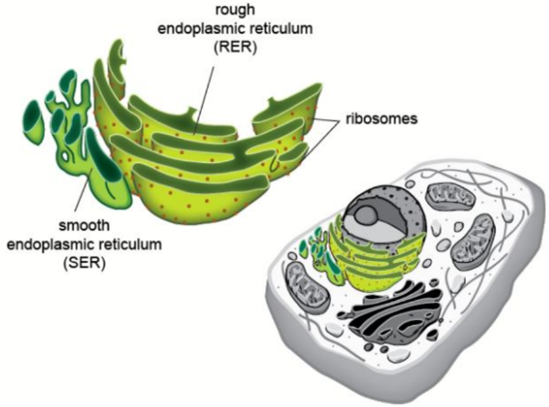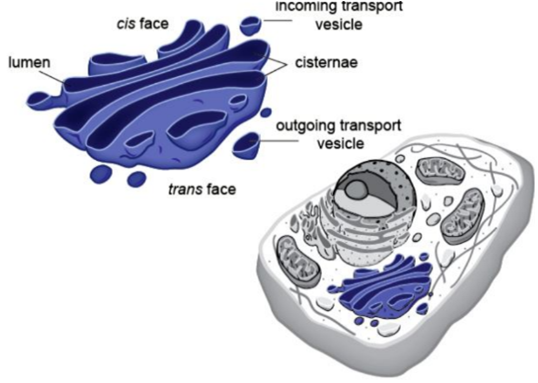CBSE
Class 10 Class 12
The cell has special components called organelles.
If we study a cell under a microscope, we would come across three features in almost every cell; plasma membrane, nucleus and cytoplasm.
A cell performs a variety of functions such as i) Synthesis of complex molecules and their breakdown, ii) Production of energy, iii) Secretion of certain substances, etc. These activities of the cell are performed by different cell organelles. These organelles are enclosed by membranes. To understand the functioning of the cell, it is necessary to know briefly about the structure of cell organelles.
The endoplasmic reticulum is a complicated and interconnected system of membrane-bound channels and tubules. It is spread throughout the cytoplasm and is continuous with the plasma membrane and nuclear membrane.
There are two types of Endoplasmic Reticulum.
Rough endoplasmic reticulum (Granular endoplasmic reticulum): They are found in cells which synthesize proteins. This type of endoplasmic reticulum possesses rough walls because the ribosomes remain attached to the membrane of the endoplasmic reticulum.
Smooth endoplasmic reticulum (Agranular endoplasmic reticulum): They are found in cells which synthesize lipid. The walls are smooth and ribosomes are not attached to its membrane.

The Golgi apparatus was first described by Camillo Golgi. Golgi complex consists of saucer-like compartments called cisternae, a network of interconnecting tubules, vesicles and vacuoles at the peripheral regions. In plant cells, Golgi apparatus is referred to as dictyosomes.

Functions of Golgi Complex
Lysosomes are small membrane-bound vesicles which contain various types of digestive enzymes. These serve as an intracellular digestive system, hence they are called digestive bags. They are produced by the joint activity of Endoplasmic reticulum and Golgi apparatus. If the membrane of Lysosome happens to get ruptured, the enzymes of Lysosome would digest the entire cellular structure causing the death of the cell. So Lysosomes are called ‘suicide bags’.
Functions of Lysosomes
It is a rod-shaped structure found in the cytoplasm of all eukaryotic cells except mammalian RBC’s.
Functions of Mitochondria :
Plastids are disc or oval-shaped organelles which occur in plant cells only. Plastids are of three types. They are Leucoplasts, Chromoplasts and Chloroplasts.
Each chloroplast consists of a double-membraned envelope and a matrix. The inner membrane is arranged along the length of the plastids as lamellae. At certain regions, the lamellae are thickened and appear like a pile of coins. These are called the grana. Each granum consists of disc-shaped membranous sacs called thylakoids. Inside these grana, the chlorophyll is located. The non-thylakoid portion of the matrix is called stroma. It contains a number of enzymes involved in photosynthesis.
Vacuoles are fluid-filled sacs bound by a single membrane and are present in plant cells as well as in certain protozoans as food vacuoles and contractile vacuoles. In plant cells, major portion of the cell is occupied by vacuoles and are bound by the definite membrane called tonoplast.
Vacuoles of plants are filled with cell sap containing minerals, sugars, amino acids and dissolved waste products.
Functions of Vacuoles
Cell wall is made of cellulose. Cell wall is present only in plant cells. It is a rigid protective covering outside the plasma membrane. Presence of cell wall in plant cells distinguishes them from animal cells. Most of the plant cell walls are made of cellulose.
The cell wall consists of three layers namely, middle lamella, primary wall and secondary wall.
Functions of Cell Wall:
A cell is enclosed in a membranous casing and is filled with a liquid substance which is called the cytoplasm. There are many cell organelles in a typical cell.
The cytoplasm is the fluid content inside the plasma membrane. It also contains many specialised cell organelles. Each of these organelles performs a specific function for the cell.
Functions of Cytoplasm
Nucleus is the major central structure in the cell. It is a dense spherical structure embedded in the cytoplasm. Nucleus has a double membraned envelope called nuclear envelope. Nuclear
envelope encloses a ground substance called nucleoplasm or karyolymph. The nuclear envelope possesses many pores called nuclear pores.
The nucleoplasm has two types of nuclear structures i) the nucleolus and, ii) chromatin.
The nucleolus is a spherical body rich in protein and RNA. It is the site of ribosome formation. There may be one or more nucleoli in the nucleoplasm.
The chromatin is a network of fine threads composed of genetic material DNA (Deoxyribonucleic acid) and proteins.
Functions of Nucleus:
The plasma membrane is a semi-permeable membrane. It is composed of a bilayer of lipid and protein. This is the outermost covering of the cell that separates the contents of the cell from its external environment. The plasma membrane allows or permits the entry and exit of some materials in and out of the cell. It also prevents movement of some other materials. The cell membrane, therefore, is called a selectively permeable membrane.
Functions of Plasma Membrane